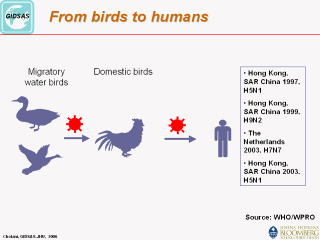| front |1 |2 |3 |4 |5 |6 |7 |8 |9 |10 |11 |12 |13 |14 |15 |16 |17 |18 |19 |20 |21 |22 |23 |24 |25 |26 |27 |28 |29 |30 |31 |32 |33 |34 |35 |36 |37 |38 |39 |40 |41 |42 |43 |44 |45 |46 |47 |review |
 |
In 1997 the first H5N1 outbreak in humans was
recorded and epidemiological investigations revealed that this outbreak was
caused by direct virus transmission from domestic birds to humans. The fear
was that the virus could mutate in humans and develop the ability of
human-to-human transmission. Only 18 cases and 6 deaths were recorded and
the entire poultry population of Hong Kong was destroyed. In 1999 another influenza virus (H9N2) known previously to only infect birds was reported in seven people in China and Hong Kong, serologic evidence suggested no person-to-person transmission. Between February and May of 2003, an extremely pathogenic avian influenza strain A sub-type H7N7 caused an outbreak in the Netherlands causing disease in 89 humans and resulted in the death of a Dutch veterinarian. The H5N1 strain that had caused human illness in 1999 has been observed causing human illness and deaths since 2003. |